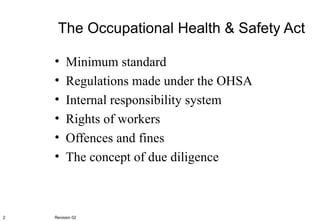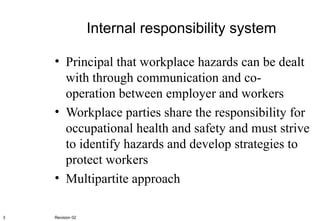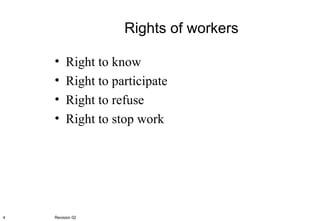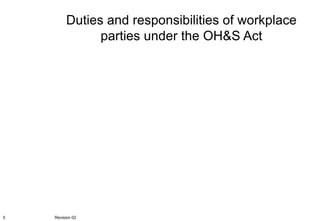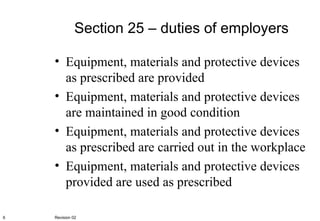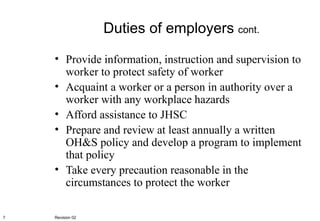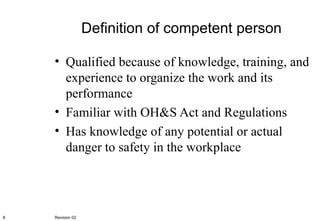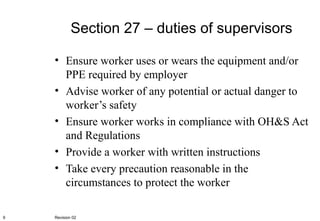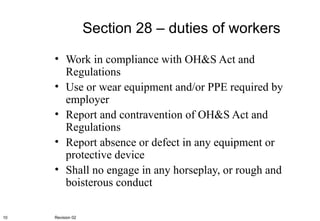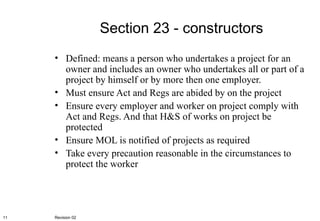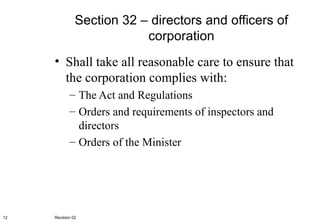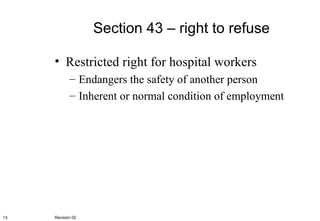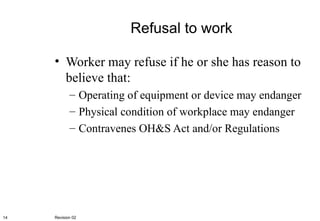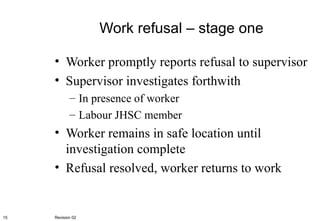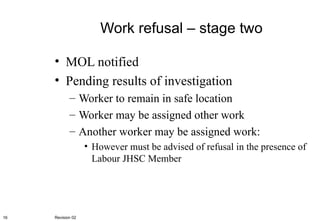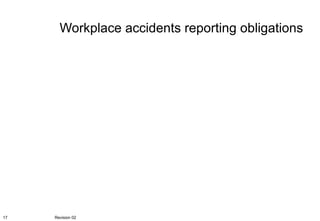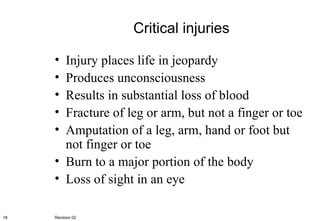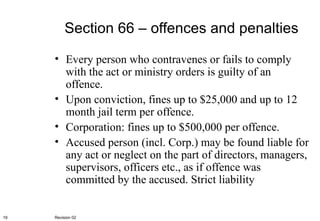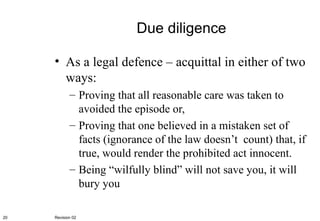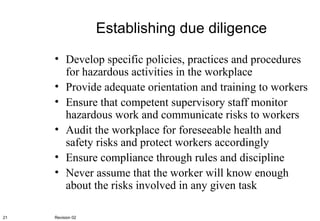OH&S
- 1. NBB002.1 Occupational health and safety
- 2. The Occupational Health & Safety Act Minimum standard Regulations made under the OHSA Internal responsibility system Rights of workers Offences and fines The concept of due diligence Revision 02
- 3. Internal responsibility system Principal that workplace hazards can be dealt with through communication and co-operation between employer and workers Workplace parties share the responsibility for occupational health and safety and must strive to identify hazards and develop strategies to protect workers Multipartite approach Revision 02
- 4. Rights of workers Right to know Right to participate Right to refuse Right to stop work Revision 02
- 5. Duties and responsibilities of workplace parties under the OH&S Act Revision 02
- 6. Section 25 – duties of employers Equipment, materials and protective devices as prescribed are provided Equipment, materials and protective devices are maintained in good condition Equipment, materials and protective devices as prescribed are carried out in the workplace Equipment, materials and protective devices provided are used as prescribed Revision 02
- 7. Duties of employers cont. Provide information, instruction and supervision to worker to protect safety of worker Acquaint a worker or a person in authority over a worker with any workplace hazards Afford assistance to JHSC Prepare and review at least annually a written OH&S policy and develop a program to implement that policy Take every precaution reasonable in the circumstances to protect the worker Revision 02
- 8. Definition of competent person Qualified because of knowledge, training, and experience to organize the work and its performance Familiar with OH&S Act and Regulations Has knowledge of any potential or actual danger to safety in the workplace Revision 02
- 9. Section 27 – duties of supervisors Ensure worker uses or wears the equipment and/or PPE required by employer Advise worker of any potential or actual danger to worker’s safety Ensure worker works in compliance with OH&S Act and Regulations Provide a worker with written instructions Take every precaution reasonable in the circumstances to protect the worker Revision 02
- 10. Section 28 – duties of workers Work in compliance with OH&S Act and Regulations Use or wear equipment and/or PPE required by employer Report and contravention of OH&S Act and Regulations Report absence or defect in any equipment or protective device Shall no engage in any horseplay, or rough and boisterous conduct Revision 02
- 11. Section 23 - constructors Defined: means a person who undertakes a project for an owner and includes an owner who undertakes all or part of a project by himself or by more then one employer. Must ensure Act and Regs are abided by on the project Ensure every employer and worker on project comply with Act and Regs. And that H&S of works on project be protected Ensure MOL is notified of projects as required Take every precaution reasonable in the circumstances to protect the worker Revision 02
- 12. Section 32 – directors and officers of corporation Shall take all reasonable care to ensure that the corporation complies with: The Act and Regulations Orders and requirements of inspectors and directors Orders of the Minister Revision 02
- 13. Section 43 – right to refuse Restricted right for hospital workers Endangers the safety of another person Inherent or normal condition of employment Revision 02
- 14. Refusal to work Worker may refuse if he or she has reason to believe that: Operating of equipment or device may endanger Physical condition of workplace may endanger Contravenes OH&S Act and/or Regulations Revision 02
- 15. Work refusal – stage one Worker promptly reports refusal to supervisor Supervisor investigates forthwith In presence of worker Labour JHSC member Worker remains in safe location until investigation complete Refusal resolved, worker returns to work Revision 02
- 16. Work refusal – stage two MOL notified Pending results of investigation Worker to remain in safe location Worker may be assigned other work Another worker may be assigned work: However must be advised of refusal in the presence of Labour JHSC Member Revision 02
- 17. Workplace accidents reporting obligations Revision 02
- 18. Critical injuries Injury places life in jeopardy Produces unconsciousness Results in substantial loss of blood Fracture of leg or arm, but not a finger or toe Amputation of a leg, arm, hand or foot but not finger or toe Burn to a major portion of the body Loss of sight in an eye Revision 02
- 19. Section 66 – offences and penalties Every person who contravenes or fails to comply with the act or ministry orders is guilty of an offence. Upon conviction, fines up to $25,000 and up to 12 month jail term per offence. Corporation: fines up to $500,000 per offence. Accused person (incl. Corp.) may be found liable for any act or neglect on the part of directors, managers, supervisors, officers etc., as if offence was committed by the accused. Strict liability Revision 02
- 20. Due diligence As a legal defence – acquittal in either of two ways: Proving that all reasonable care was taken to avoided the episode or, Proving that one believed in a mistaken set of facts (ignorance of the law doesn’t count) that, if true, would render the prohibited act innocent. Being “wilfully blind” will not save you, it will bury you Revision 02
- 21. Establishing due diligence Develop specific policies, practices and procedures for hazardous activities in the workplace Provide adequate orientation and training to workers Ensure that competent supervisory staff monitor hazardous work and communicate risks to workers Audit the workplace for foreseeable health and safety risks and protect workers accordingly Ensure compliance through rules and discipline Never assume that the worker will know enough about the risks involved in any given task Revision 02

